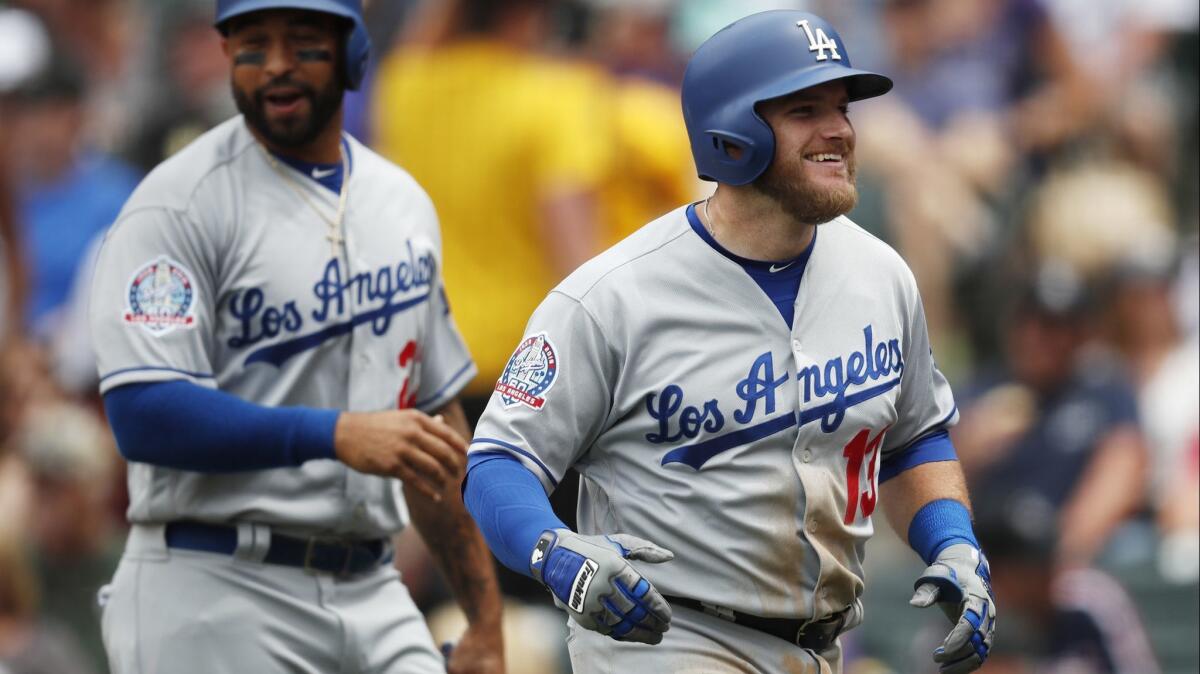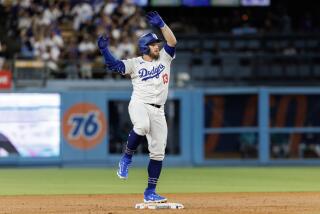Dodgers gave Max Muncy a second chance, and he’s making the most of it
- Share via
The sequence of events which delivered Max Muncy into the middle of the Dodgers lineup began 14 months ago with a text message.
It was sent by general manager Farhan Zaidi, who knew Muncy during their time together in Oakland. Soon after the Athletics released Muncy on March 31, 2017, Zaidi reached out and asked a question: Do you want a job?
“I was sitting there on opening day at home on the couch, watching all my friends getting announced, going out on the field and starting the season,” Muncy said. “It was the first time that ever happened to me. That was tough. But the more you sit there, the more you watch the games, you realize how much you miss it. You realize how much you enjoy playing it.”
Muncy put Zaidi in touch with his agent. The Dodgers did not have openings at first base or third base or second base or either outfield corner or any other position Muncy had tried during his career. But their quest for maintaining roster depth is quixotic and constant. Sometimes the rewards are immediate; sometimes the satisfaction is delayed.
Muncy, 27, signed a minor-league contract and spent 2017 with triple-A Oklahoma City. His value would not reveal itself until injuries brought him to the big-league level in April. As the Dodgers (35-32) prepare to host San Francisco this weekend, Muncy has emerged as the team’s improbable leader in home runs (13), on-base percentage (.395) and slugging percentage (631).
His primacy is not merely a reflection of his teammates: Muncy’s 1.030 on-base plus slugging percentage ranks fourth in the majors among hitters with at least 150 plate appearances. Only Mookie Betts, Mike Trout and J.D. Martinez have been more prolific at the plate.
“I didn’t expect to see the consistent slugging, the ability to barrel baseballs,” manager Dave Roberts said. “This guy, he knows where the barrel is at.”
Like Chris Taylor a year ago, Muncy serves as a low-wattage addition providing high-profile benefits. He has played a variety of roles with the club. He handled third base while Justin Turner recovered from a fractured wrist. He played first base while Cody Bellinger slumped. With both Bellinger and outfielder Joc Pederson heating up, Muncy shifted to second base as the team sought to repair the sinkhole at that position.
Muncy is not considered a natural in the field by scouts. He has always compensated with his bat. Growing up in a bedroom community in the northwest corner of the Dallas-Fort Worth metroplex, Muncy was a polished hitting prospect. Cleveland drafted him in the 41st round of the 2009 draft, but Muncy opted for college.
After Muncy signed with Baylor, Steve Smith, the Bears’ coach back then, asked a pro scout where to play him. “I’ll never forget it,” Smith said. “The guy said ‘Put him as far away from the ball as you can.’ He had a bit of a reputation.”
Smith added: “Nobody ever really questioned his bat. It was more about where you were going to put him on the field. We tried him at a number of places, but he eventually landed at first base.”
Muncy chewed up college pitching. He produced a .909 OPS in three seasons with Baylor because “his hands and his bat speed are special,” Smith said. His power, though, was less apparent: Muncy hit 27 homers in his college career, and teams are often wary of committing to first-base prospects who have not shown significant slugging potential.
Oakland had three first-round picks in 2012. They considered Muncy for one of those slots, but held off because of his uncertain defensive value. He was still available in the fifth round. “A lot of what we’re seeing right now — the power, the plate discipline, the short power stroke — were attributes he had back in college,” Zaidi said. “The guys felt like it was just a really high probability bat.”
In his first full season in the minors, Muncy hit 25 home runs between Class A and double-A. His power went dormant from there. He made it to the majors with Oakland in 2015 and 2016, but struggled to produce. Muncy finished his Athletics career with five homers and a .611 OPS in 96 games.
When the 2017 season began, Muncy got caught in a roster crunch. He had not performed well enough for the big-league roster. The Athletics did not want him siphoning away at-bats in the minors from infield prospects Matt Chapman and Matt Olson. The release made sense. It still stung.
“At that point, the ship had sailed for me,” Muncy said. “It was time to part ways, for both of us. It sucked that it happened, but I’m kind of thankful. Sometimes all you need is a fresh start somewhere.”

As he prepared for a second chance with the Dodgers, Muncy made a series of alterations at the plate. The adjustments ranged from the positioning of his hands to the width of his feet to the curvature of his spine. He ditched the upright posture he had used in Oakland and hunkered down. He also amplified his aggression. “All those things put together made a huge change for me,” he said.
Muncy finished the year with the highest on-base percentage (.414) and slugging percentage (.491) of his career at any level. The Dodgers considered calling him up in September, but “we already had 82 guys up,” Zaidi cracked. During the summer, former hitting coach Tim Hyers visited Oklahoma City and came back with a rave report on Muncy. “This is a real guy,” Hyers told his bosses.
It still took a series of injuries for Muncy to find his footing in the majors. After Turner’s wrist was broken, Logan Forsythe hurt his shoulder playing third base. Muncy filled the void. He started to heat up in May and caught fire this month, with six home runs in 10 games.
After Muncy went deep on Tuesday, Roberts was posed a question: When Roberts manages the National League in the All-Star Game next month, where will Muncy be in the lineup? Roberts smiled. “Batting third,” he said. “And playing wherever he wants.”
Muncy was not sure how to respond to that. The journey that started with a text message a little over a year ago is far from over.
“I try not to think about it,” Muncy said. “It’s hard not to. But right now, I’m just trying to show up and take it one day at a time.”
Twitter: @McCulloughTimes
More to Read
Are you a true-blue fan?
Get our Dodgers Dugout newsletter for insights, news and much more.
You may occasionally receive promotional content from the Los Angeles Times.







